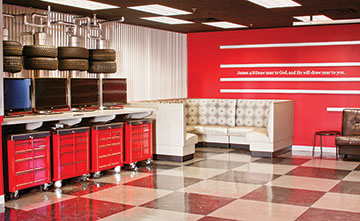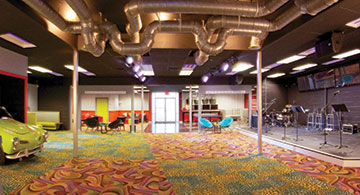

By Paulla Shetterly
Some among the next generation of believers have become disillusioned with the traditional worship environment. Because of this, we, as designers, have had to rethink how we address the needs of today’s culture without repositioning the timeless truths of the church.
It’s a tactical process often involving theming worship and student environments. I’ve learned that the designs must be progressive, because congregations — students and their parents — are progressive.
This can be a huge challenge for churches. Students want to hear truth, but they want it presented in a way that speaks to their needs and their personal experiences.
Theming has become very popular because it represents a commitment, an investment and a buy-in to the lives of others — particularly students and children.
Students are looking for churches that offer an intentional worship experie nce. How a church deals with this often boils down to the design of a facility.
How it takes shape
In designing a worship space for children, we adjust the scale of the themed environment to fit their perspectives. Colors are more intense, elements are added to fit their age group, and areas are designed to be fun and full of natural light. We want them to be eager to go to church and eager to return. We also design secure check-in areas and systems.
A major challenge for many churches is creating areas that look and feel like the age group that will be using them. If a church is going to grow and retain its students, the spaces must be sophisticated places of engagement and also take advantage of the latest in technology. Designs should incorporate lighting, color schemes and surfaces that are colorful and durable.
For younger ages, spaces can contain designs that bring Bible characters to life, plus stage areas for speakers and drama.
Older students enjoy areas where social involvement takes place, including rock-climbing walls, basketball courts, recreation areas, cafes, and areas where students can just hang out.
In the past, churches would paint rooms bright colors, add seating, and think this was a way to reach their youth and students. This is no longer true. Today, student areas contain cafes, games areas, sound and visual displays, and places to meet and get involved. More and more churches are seeking to create a “life experience” atmosphere rather remaining a once-a-week destination.

One student area we created for a church is called The Garage. (See photos, above) We met with the youth pastor and immediately caught his vision for this new student space. We decided on this theme but made sure it wasn’t just an area where guys felt comfortable by adding gender-neutral, broadly engaging elements.
This facility has been a catalyst for growth and student retention. It’s a safe place where preteens and high school students can meet, worship and be honest with one another. Parents can see what’s going on and are very supportive.
One student minister told me: “Theming is used to teach our students that living their faith is a way of life. It’s a part of who they are. It also lets them know that the church cares enough to spend money to create environments for them.”
Paulla Shetterly, RID, IIDA, LEED AP, EDAC — an award-winning leader in religious design — is an associate principal and director of Interior Design with CDH Partners located in Marietta, GA.


